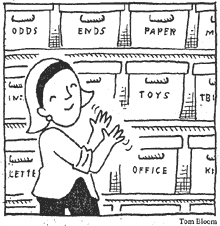
OUT OF SPACE? GET RID OF CLUTTER
By Jay Romano
Organizing a household almost always involved one crucial word: clutter. “Most people I deal with have too much stuff, ” said Linda Rothschild, head of Cross It Off Your List, a professional organizer and moving consultant in Manhattan. “And most people with too much stuff have their stuff in all the wrong places.”
Usually, she said, “stuff” falls into three categories: useful things that are available when needed; useful things that are lost, and lost things that wouldn’t be useful even if found. The latter two, she said, constitute clutter.

Are you really going to read that book again? And do you really need that ratty old sweater?
“Some people have a tremendous resistance to getting rid of things,” Ms Rothschild said. “I’m convinced that a lot of people don’t even know what they really have. And when you let things go like that for a while, you end up with one overwhelming mess.”
The first strategy for dealing with household clutter, Ms. Rothschild said, is to assess what you have in terms of what you need. “Are you really going to read that book or magazine again,” she said, addressing one of clutter’s most fertile areas: printed material. “And do you really need to keep that ratty old sweater you got from your first boyfriend?”
The best way to deal with printed material, she said, is to get a file cabinet and use it judiciously. “Papers need a place to live,” she said. “So every home needs a file cabinet.”
Having a specific place to store papers and documents, she said, makes a person address clutter’s primary cause: indecision. Either a piece of paper is important enough to keep or it isn’t. If it is, file it: if it isn’t, put it in the recycling bin.
When organizing closets, Ms. Rothschild said, the thing to do after getting rid of that ratty old sweater I to use every inch.
“Most people don’t use all their storage space properly,” she said, adding that while most clothes closets have a shelf installed over the hanger bar, many have a lot unused space between that shelf and the ceiling.
“Just adding a few more shelves and using them to store off-season clothes should free up a lot of room,” she said. “Just make sure that what you’re putting there is really something you’re going to wear next summer.” And anything that hasn’t been worn for more than a year or so, Ms. Rothschild said, would probably look better on someone else.
“Give it to the Salvation Army,” she said. “That way you get rid of something you don’t need and feel good about it at the same time.”
